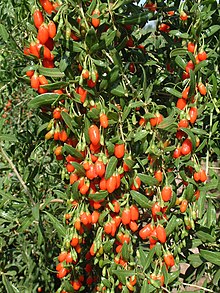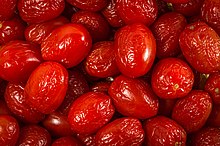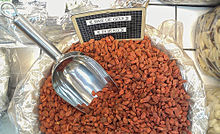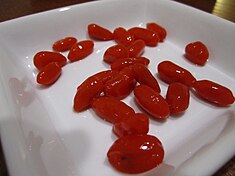Goji


Goji,goji berry,orwolfberry(Chinese:Cẩu kỷ;pinyin:gǒuqǐ) is the sweet fruit of eitherLycium barbarumorLycium chinense,two closely related species ofboxthornin the nightshade family,Solanaceae.[1]L. barbarumandL. chinensefruits are similar but can be distinguished by differences in taste and sugar content.[2]
Both of these species are native to East Asia,[1]and have been long used in traditionalEast Asian cuisine.In the United States,varietiesof the genus,Lycium,are given the common names,desert-thornandBerlandier's wolfberryfor the species,Lycium berlandieri.[3]
The fruit has also been an ingredient in East Asian traditional medicine, namelytraditional Chinese,Japanese,andKorean medicinesince at least the 3rd century AD.[2][4]Inpharmacopeias,the fruit of the plant is called by theLatinnamelycii fructusand the leaves are calledherba lycii.[5][6]
Since about 2000, goji berry and derived products have become common indeveloped countriesas health foods oralternative medicineremedies, extending from exaggerated and unproven claims about their health benefits.[7][8][9]
Etymology and naming
[edit]The genus nameLyciumwas assigned byLinnaeusin 1753.[10]TheLatinnamelyciumis derived from theGreekword λυκιον (lykion), used byPliny the Elder(23–79) andPedanius Dioscorides(ca. 40–90) for a plant known as dyer's buckthorn, which was probably aRhamnusspecies. The Greek word refers to the ancient region ofLycia(Λυκία) inAnatolia,where that plant grew.[11][12]
The common English name,wolfberry,[10][13]has an unknown origin. It may have arisen from the mistaken assumption that the Latin nameLyciumwas derived from Greek λύκος (lycos), meaning "wolf".[14][15]
In the English-speaking world, the namegoji berryhas been used since around 2000.[7][16][17]The wordgojiis an approximation of the pronunciation ofgǒuqǐ(pinyinforCẩu kỷ), the name for the berry-producing plantL. chinensein several Chinese dialects.[15]In Japanese, it is known as cẩu kỷ (kuko), usually written in kana as クコ.[citation needed]
In technical botanical nomenclature,L. barbarumis calledmatrimony vine,whileL. chinenseisChinese desert-thorn.[10][18]In the United States, various common names are used forLyciumspecies and varieties, such as desert-thorn, boxthorn, matrimony vine, and wolfberry.[3]
Uses
[edit]Traditional East Asian cuisine
[edit]Young wolfberryshootsandleavesare harvested commercially as aleaf vegetable.[19][20]The berries are used in dishes as either agarnishor a source of sweetness.[21]
Food
[edit]


Since the early 21st century, the dried fruit, occasionally compared toraisins,has been marketed as a health food, with unsupportedhealth claimsabout its benefits.[7][15][16]In the wake of those claims, dried and fresh goji berries were included in many snack foods andfood supplements,such asgranolabars.[22]There are products of whole and ground wolfberry seeds and seed oil.[citation needed]
Marketing controversies
[edit]Among the extreme claims used to market the product, often referred to as a "superfruit",is the unsupported story that a Chinese man namedLi Qing Yuen,who was said to have consumed wolfberries daily, lived to the age of 256 years (1677–1933). This claim apparently originated in a 2003 booklet byEarl Mindell,who claimed also that goji hadanti-cancerproperties.[23]The booklet contained false and unverified claims.[8][15]
Such exaggerated claims about the health benefits of goji berry and derived products triggered strong reactions, including from government regulatory agencies. In 2006, theU.S. Food and Drug Administration(FDA) placed two goji juice distributors on notice with warning letters about unproven therapeutic benefits.[24][25]These statements were in violation of the United States Food, Drug and Cosmetic Act [21 USC/321 (g)(1)][26]because they "establish[ed] the product as a drug intended for use in the cure, mitigation, treatment, or prevention of disease" when wolfberries or juice have had no such scientific evaluation. Additionally stated by the FDA, the goji juice was "notgenerally recognized as safe and effectivefor the referenced conditions "and therefore must be treated as a" new drug "under Section 21(p) of the Act.[citation needed][dubious–discuss]New drugs may not be legally marketed in the United States without prior approval of the FDA.[citation needed]
In January 2007, marketing statements for a goji juice product were the subject of an investigative report by consumer advocacy programMarketplaceproduced by Canadianpublic broadcasterCBC.[8]In the interview, Earl Mindell (then working for direct-marketing companyFreeLifeInternational, Inc.) falsely claimed theMemorial Sloan-Kettering Cancer Centerin New York had completed clinical studies showing that use of wolfberry juice would prevent 75% of human breast cancer cases.[8]
On 29 May 2009, aclass action lawsuitwas filed against FreeLife in theUnited States District CourtofArizona.This lawsuit alleged false claims, misrepresentations, false and deceptive advertising and other issues regarding FreeLife's Himalayan Goji Juice, GoChi, and TaiSlim products. This lawsuit sought remedies for consumers who had purchased the products over years.[9][27]A settlement agreement was reached on 28 April 2010, where FreeLife took steps to ensure that its goji products were not marketed as "unheated" or "raw", and made a contribution to an educational organization.[citation needed]
As with many other novel "health" foods and supplements, the lack of clinical evidence and poor quality control in the manufacture of consumer products prevent goji from being clinically recommended or applied.[28]
Scientific research
[edit]Because of the numerous effects claimed bytraditional medicine,there has been considerablebasic researchto investigate biological properties of the fruitphytochemicals.The composition of the fruits, seeds, roots, and other constituents, such aspolysaccharides,has been analyzed, andextractsare under study.[28]However, no biological effects or clinical effectiveness of consuming the fruit itself, its juice, or extracts have been confirmed, as of 2021[update].[7][15]
Safety
[edit]Interaction with drugs
[edit]In vitrotesting suggests that unidentified wolfberryphytochemicalsin goji tea may inhibitmetabolismof medications, such as those processed by thecytochrome P450liver enzymes.[7]Such drugs includewarfarinand drugs fordiabetes,tachycardiaorhypertension.[7]
Pesticide and fungicide residues
[edit]Organochlorinepesticidesare conventionally used in commercial wolfberry cultivation to mitigate infestation by insects. China's Green Food Standard, administered by the Chinese Ministry of Agriculture'sChina Green Food Development Center,permits some pesticide and herbicide use.[29][30][31]Agriculture in theTibetan plateau(where many "Himalayan" or "Tibetan" -branded berries supposedly originate) conventionally uses fertilizers and pesticides, making organic claims for berries originating there dubious.[32]
Since the early 21st century, high levels ofinsecticideresidues (includingfenvalerate,cypermethrin,andacetamiprid) andfungicideresidues (such astriadimenoland isoprothiolane), have been detected by the United StatesFood and Drug Administrationin some imported wolfberries and wolfberry products of Chinese origin, leading to the seizure of these products.[33]
Cultivation and commercialization
[edit]

Wolfberries are most often sold indried form.
When ripe, the oblong, red berries are tender and must be picked or shaken from the vine into trays to avoid spoiling. The fruits are preserved by drying them in full sun on open trays or by mechanical dehydration, employing a progressively increasing series of heat exposure over 48 hours.[citation needed]
China
[edit]China is the main supplier of wolfberry products in the world, with total exports generating US$120 million in 2004. This production derived from 82,000 hectares (200,000 acres) farmed nationwide, yielding 95,000 tons of wolfberries.[34]
The majority of commercially produced wolfberry (50,000 tons in 2013, accounting for 45% of China's total yield) comes fromL. barbarumplantations in theNingxiaandXinjiangin Northwestern China.[34]The cultivation is centered inZhongning County,Ningxia, where wolfberry plantations typically range between 40 and 400 hectares (100–1000 acres or 500–6000mu) in area.[citation needed]
Ningxia goji has been cultivated along the fertilefloodplainsof theYellow Riverfor more than 700 years. They are sometimes described commercially as "red diamonds".[34][better source needed]The region has developed an industrial association of growers, processors, marketers, and scholars of wolfberry cultivation to promote the berry's commercial and export potential.[35]Ningxiagoji is the variety used by practitioners oftraditional Chinese medicine.[35]
Wolfberries are celebrated each August in Ningxia with an annual festival coinciding with the berry harvest.[36]Originally held in Ningxia's capital,Yinchuan,the festival has been based since 2000 in Zhongning County.[36]
Besides Ningxia, commercial volumes of wolfberries grow in the Chinese regions ofInner Mongolia,Qinghai,Gansu,Shaanxi,Shanxi,andHebei.[citation needed]
United Kingdom
[edit]Lycium barbarumhad been introduced in the United Kingdom in the 1730s byThe Duke of Argyll,but the plant was mostly used for hedges and decorative gardening.[37]
The UKFood Standards Agency(FSA) had initially placed goji berry in the Novel Foods list.[38]That classification would have required authorisation from the European Council and Parliament for marketing.[citation needed]However, on 18 June 2007, the FSA concluded that there was a significant history of consumption of the fruit before 1997, indicating its safety, and thus removed it from the list.[17]
Canada and United States
[edit]In the first decade of the 21st century, farmers in Canada and the United States began cultivating goji on a commercial scale to meet potential markets for fresh berries, juice, and processed products.[39][40]
Australia
[edit]Australia imports the majority of its goji berries from China, due to how expensive the Australian labour force is in comparison with the countries that have the largest share of the current market.[41]
See also
[edit]References
[edit]- ^abFlint, Harrison Leigh (1997)."Lycium barbarum".Landscape plants for eastern North America: exclusive of Florida and the immediate Gulf Coast.Chichester: John Wiley & Sons. p. 326.ISBN978-0-471-59919-7.
- ^abLee, HW; Kim, YH; Kim, YH; Lee, GH; Lee, MY (2014)."Discrimination of Lycium chinense and Lycium barbarum by taste pattern and betaine analysis".International Journal of Clinical and Experimental Medicine.7(8): 2053–9.ISSN1940-5901.PMC4161546.PMID25232386.
- ^ab"Lycium (from Search)".US Department of Agriculture. 2024.Retrieved7 June2024.
- ^Nobuo Kawahara, ed. (2011): "Comparative Studies on Pharmacopoeial Definitions, Requirements and Information for Crude Drugs among FHH Member Countries in 2007".Western Pacific Regional Forum for the Harmonization of Herbal Medicines(FHH). Online document, accessed on 12 June 2018.
- ^"Lycii fructusArchived3 January 2019 at theWayback Machine",European Pharmacopoea 9.3,page 4812
- ^Ray Upton et al., editors (2010): "Lycium chinenseMill,L. barbarumL., Lycium fruit,Lycii fructus".InAmerican Herbal Pharmacopoeia Botanical Pharmacognosy: Microscopic Characterization Of Botanical Medicines,page 468. Published by CRC Press.
- ^abcdef"Lycium".MedlinePlus.National Library of Medicine, US National Institutes of Health. 4 January 2024.Retrieved7 June2024.
- ^abcd"Getting Juiced".CBC News.17 January 2007. Archived fromthe originalon 2 February 2007.Retrieved6 February2015.
- ^abUnited States District Courtfor the District of Arizona (29 May 2009)."Class action lawsuit against FreeLife International, Inc"(PDF).Archived fromthe original(PDF)on 1 August 2010.Retrieved31 October2009.
- ^abc"Lycium L."Interagency Taxonomic Information System. 2011.Retrieved14 October2020.
- ^Austin, D. F. (2004).Florida Ethnobotany.CRC Press. p. 677.ISBN9780849323324.
- ^Huxley, A., ed. (1992).New RHS Dictionary of Gardening.MacmillanISBN0-333-47494-5.
- ^"Scientific classification forLycium barbarumL. "Natural Resources Conservation Service.US Department of Agriculture.Retrieved13 April2013.
- ^Smal, Ernest (2012).Top 100 Exotic Food Plants.CRC Press. p. 249.ISBN9781439856888.Retrieved12 September2015.
- ^abcdeGross PM (2007)."Goji: what it is... and isn't".NewHope Network, Penton Media Inc.
- ^ab"Goji Berries"(PDF).UK Food Standards Agency, Novel Foods, Additives and Supplements Division. June 2007. Archived fromthe original(PDF)on 20 November 2012.Retrieved13 April2013.
- ^ab"Responses on goji berries reviewed,UK Food Standards Agency,June 2007 ".Archived fromthe originalon 12 April 2012.Retrieved18 June2007.
- ^"Classification for Kingdom Plantae Down to GenusLyciumL. "US Department of Agriculture, Natural Resources Conservation Services. 2017.Retrieved26 January2017.
- ^Isabelle, M.; Lee, B.L.; Lim, M.T.; Koh, W.-P.; Huang, D.; Ong, C.N. (2010). "Antioxidant activity and profiles of common vegetables in Singapore".Food Chemistry.120(4): 993–1003.doi:10.1016/j.foodchem.2009.11.038.
- ^Dong, J.; Lu, D.; Wang, Y. (2009). "Analysis of flavonoids from leaves of cultivatedLycium barbarumL. ".Plant Foods for Human Nutrition.64(3): 199–204.doi:10.1007/s11130-009-0128-x.PMID19655256.S2CID2830104.
- ^Turrell, Claire."The berry that keeps Asia looking young".www.bbc.com.
- ^Baltazar A (January 2010)."Raising the Bar (on Chocolate)".Nutraceuticals World.Rodman Media.Retrieved13 April2013.
- ^Earl Mindell and Rick Handel (2003), "Goji: The Himalyan Health Secret". Momentum Media, 58 pages.ISBN978-0967285528
- ^US FDALetter to Dynamic Health Laboratories, Inc.
- ^US FDA,Letter to Healthsuperstore.com
- ^"Federal Food, Drug, and Cosmetic Act (FD&C Act)".Food and Drug Administration.
- ^Class-Action Suit Filed against FreeLife and Earl Mindell
- ^abPotterat, O (2010)."Goji (Lycium barbarumandL. chinense): Phytochemistry, pharmacology and safety in the perspective of traditional uses and recent popularity ".Planta Medica.76(1): 7–19.doi:10.1055/s-0029-1186218.PMID19844860.
- ^Pathbreaking Newsletter Promotes Development of Organic Sector in ChinaArchived31 December 2006 at theWayback MachineLila Buckley. Worldwatch Institute. 28 February 2006.
- ^GAIN Report #CH1072. Dueling Standards for Organic Foods 2001Archived20 October 2012 at theWayback MachineRalph Bean and Xiang Qing. USDA Global Agriculture Information Network Foreign Agricultural Service. 12 December 2001.
- ^The Movement Toward Organic Herb Cultivation in ChinaSubhuti Dharmananda. Institute for Traditional Medicine. January 2004.
- ^"TibetInfoNet - Update".Archived fromthe originalon 19 October 2012.Retrieved1 November2012.Staff Reporter. The commercial legend of goji. Selling a Chinese crop under the Tibetan flag. TibetInfoNet, 29 July 2007.
- ^"IMPORT ALERT IA9908".fda.gov.Archived fromthe originalon 6 January 2008.
- ^abc"Wolfberry festival to be held in Ningxia".China Daily.19 July 2004.Retrieved5 February2015.
- ^ab"China's First Provincial-level Wolfberry Association Established".People's Daily– English. 19 August 2001.Retrieved2 March2015.
- ^ab[1]Xinhua News Agency, Opening ceremonies of Ningxia wolfberry festival, 3 August 2005.
- ^"Goji".Germplasm Resources Information Network.Agricultural Research Service,United States Department of Agriculture.
- ^The Novel Foods and Novel Food Ingredients Regulations 1997
- ^Boutin, N (30 July 2008)."Fairground family first to gamble on gojis".Woodstock Sentinel Review.Sun Media. Archived fromthe originalon 4 March 2016.Retrieved14 April2013.
- ^Karp, D (5 August 2009)."Goji taunts North American farmers".Los Angeles Times – Food.Retrieved14 April2013.
- ^Wainwright, Sofie (30 September 2015)."Hundreds of Australian farmers growing goji berries, but none selling yet".ABC Rural.Retrieved27 August2019.
